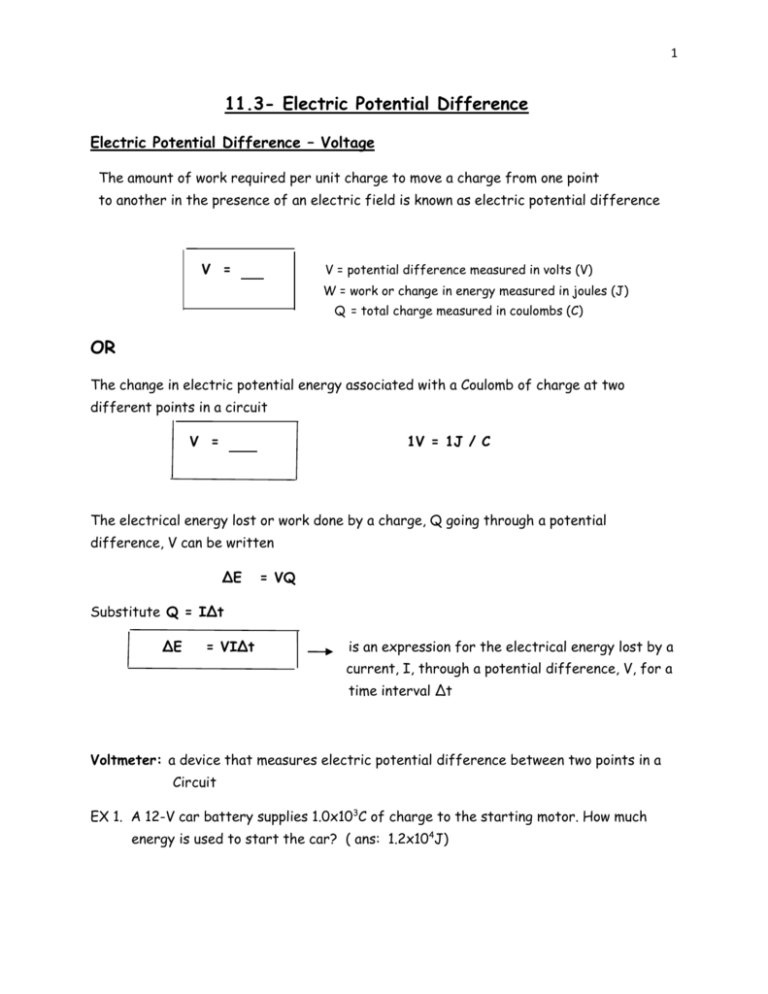Electric Potential Difference Practice Problems
advertisement

1 11.3- Electric Potential Difference Electric Potential Difference – Voltage The amount of work required per unit charge to move a charge from one point to another in the presence of an electric field is known as electric potential difference V = V = potential difference measured in volts (V) W = work or change in energy measured in joules (J) Q = total charge measured in coulombs (C) OR The change in electric potential energy associated with a Coulomb of charge at two different points in a circuit V = 1V = 1J / C The electrical energy lost or work done by a charge, Q going through a potential difference, V can be written ∆E = VQ Substitute Q = I∆t ∆E = VI∆t is an expression for the electrical energy lost by a current, I, through a potential difference, V, for a time interval ∆t Voltmeter: a device that measures electric potential difference between two points in a Circuit EX 1. A 12-V car battery supplies 1.0x103C of charge to the starting motor. How much energy is used to start the car? ( ans: 1.2x104J) 2 EX2. If a current of 1.0 x 101 A takes 3.0x102 s to boil a kettle of water requiring 3.6 x 105J of heat energy, what is the potential difference (voltage) across the kettle? (ans:1.2 x 10 2V) Practice: 1. A hair dryer has 1.2 × 103C of charge passing through a point in its circuit when it is connected to a 120-V power supply. How much energy is used by the hair dryer? (ans:1.4 x 105J) 2. Write an equation for each of the following: (a) charge in terms of energy used and voltage (b) voltage in terms of charge and energy used 3. A light bulb operating on an electric current of 0.83 A is used for 2.5 h at an electric potential difference of 120 V. How much energy is used by the light bulb? (ans: 9.0 x 105J) 4. Write an equation for each of the following: (a) electric current in terms of energy used, voltage, and time interval (b) voltage in terms of electric current, energy used, and time interval (c) time interval the device is used in terms of current, voltage, and energy used 5. A 120-V electric sander operating for 5.0 min uses 1.0 × 105J of energy. Find the current through the sander. (ans: 2.8 A) 3 6. An electric can opener used in a 120-V circuit operates at 2.2 A using 9.5 × 105J of energy all year. How long was the can opener used for that year? (ans: 3.6 x 103 s) 7. What amount of energy does a kettle use to boil water if it has 810 C of charge passing through it with a potential difference of 120 V? (ans: 9.7 × 104J) 8. What is the potential difference across a refrigerator if 75 C of charge transfers 9.0 x 103J of energy to the compressor motor? (ans: 120 V) 9. An electric baseboard heater draws a current of 6.0 A and has a potential difference of 240 V. For how long must it remain on to use 2.2 x 105J of electrical energy? (ans: 1.5 x 102 s) 10. A flash of lightning transfers 2.0 x 109J of electrical energy through a potential difference of 7.0 x 107V between a cloud and the ground. Calculate the quantity of charge transferred in the lightning bolt. (ans: 29 C) 11. Calculate the energy stored in a 9.0 V battery that can deliver a continuous current of 4.0 mA for 2.0 x 103 s. (ans: 72 J) 12. If a charge of 0.30 C moves from one point to another in a conductor and, in doing so, releases 5.4 J of electrical energy, what is the potential difference between the two points? (ans: 18 V)







